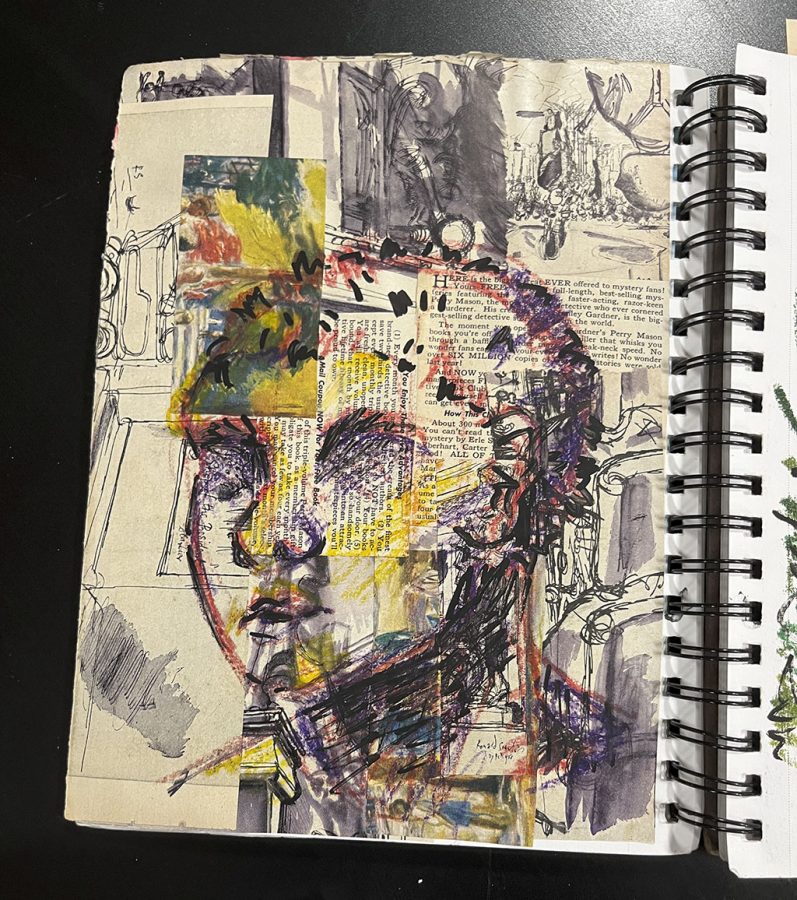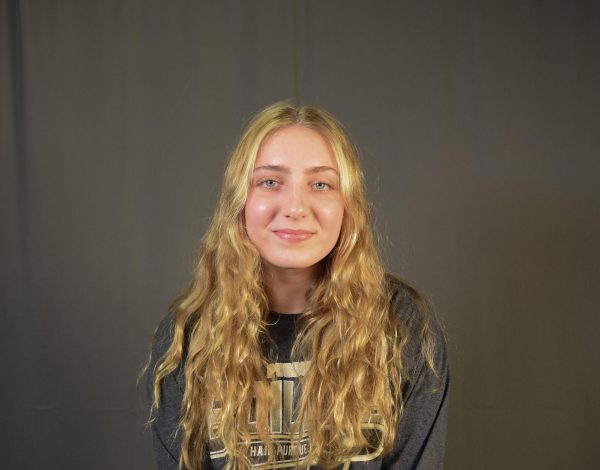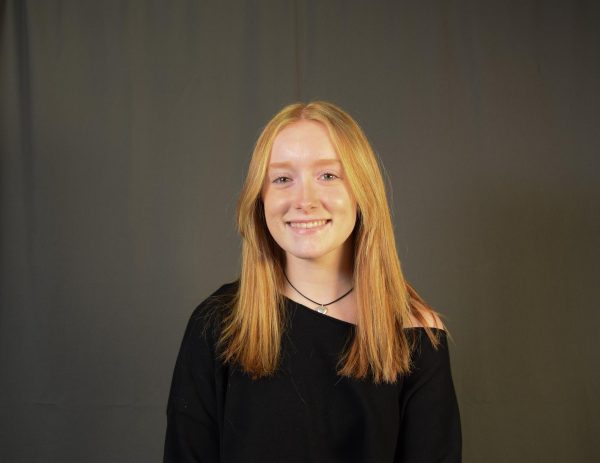True colors: NHS artists open up about the meanings behind their creations
Photo by tori rowe
Abstract collage piece by Jenna Chreist. Her art is an active hobby she enjoys to share with others.
January 19, 2023
Art is a historically worldwide concept. Its paint strokes stretch across decades and oceans. Its carved clay travels across centuries and lands. However, an art piece’s meaning passes through touched hearts and reminiscent minds. The meanings behind art created by Noblesville’s very own students often shape the audience, the artist, and the art itself.
Sympathy
Lucian Dixon, a senior at NHS, has always gravitated to art as an outlet their whole life. Dixon has always had an interest in the ability to be able to visually express themself and help society understand them.
“I’ve drawn since I could pick up a pencil, … I was interested in the fact that you [could] literally just pick up something and make things that your brain makes up in your head,” Dixon said.
Dixon’s art holds more importance than it may seem, with their art being a manifestation of their emotions whilst expressing it to society in a way they can comprehend. Their interest blossomed into the ability to express themselves to society to portray something bigger than themself.
“I try to spread images to help with understanding and show how it feels to help others have insight into what different experiences are like for others, especially experiences of disorders with negative stigma,” Dixon said.
Experiencing mental health struggles and feelings of ostracization, Dixon tends to draw inspiration from personal experience. By pushing to make an impact, they manage to educate others while also helping themself come to terms with things they are facing in their life.
“As a misunderstood, autistic queer person, I’ve had many personal experiences in my life, positive and negative, that I express through my art and have helped me grow and express myself better,” Dixon said, “many of the feelings within myself manifest, even unintentionally, into my artwork and give it a more personal meaning,” Dixon said.
Art throughout the years has always been a source of expression for many artists to express things usually left unsaid. Dixon understands the importance of this and bringing light to these hard subjects.
“Many of my pieces aim to dispel negative stigma around ‘controversial’ topics using very feeling oriented art to bring out the sympathy in the viewers,” Dixon said.
Headspace
Leo Hanafee, a junior at NHS, discovered art at a young age and has used it as an outlet ever since. He uses his own interpretations of the world around him as an expression of his feelings.
“I really started to take it seriously in middle school, it was a way for me to express how I felt and cope with everything happening around me,” Hanafee said.
For Hanafee, art is not just a hobby, it is a way to reveal what he is truly thinking.
“Most of my art reflects my interests and my head space at the moment. I get new ideas for art from the world around me, and I like to incorporate those ideas into my interests,” Hanafee said.
A variety of emotions are evoked from the diverse range of art that Hanafee creates. He hopes to connect with people by using more complex ideas than what is visible on the surface.
“I always want people to look at my art and feel or at least be able to see a specific emotion,” Hanafee said.
Not only is his art full of bright colors on the surface, but they have more significance than what might be expected at first glance.
“Most pieces of mine that have deeper meanings reflect my identity or struggles that I have been through that stick with me,” Hanafee said. “Art is my way to express how I feel without words, it helps me get emotions out.”
For Hanafee, art is part of his everyday life, and its importance does not go unnoticed. It is truly a defining characteristic of his passion.
“It may sound cliché, but without [art] I feel like something is missing. Art is a very important part of who I am, and I will always make time for it,” Hanafee said.
Artists often face the pressure of their work being held to certain standards, when in reality, everyone expresses themselves differently and finds it difficult to fit into what society deems as perfect. Hanafee feels it is important for artists to know they do not have to conform to what they think other people will prefer.
“Good art is something that is so subjective and personal, I believe that it can be a hobby for anyone, whether they feel they are good at it or not,” Hanafee said. “There is always a pressure to create something new and different and I think that ruins art for a lot of people, it should be a hobby anyone can enjoy with no pressure.”
Something Beautiful
Junior Jenna Chreist grew from scribbling doodles on paper to developing intricate pieces that depict the beauty of her environment. Chreist, drawing inspiration from reality or imagination, is able to transfer her ideas into a tangible, portrayal of talent.
“I just draw what I see, be that in real life or my imagination,” Chreist said.
Although what she sees may just be an ordinary item, Chreist strives to embrace any dullness of an object. Through her art, she is then able to reveal the underlying vibrancy that is hidden in the miniscule details. When she is not feeling generally inspired, Chreist embraces her own boredom to generate artistic prompts.
“Sitting idly when I have nothing else to do will always bring me to draw in one way or another,” Chreist said.
Chreist does not think her art always has a specific or intended meaning behind its mirage of paint strokes and lead sketches.
“I allow the audience to assign their own meanings to my pieces,” Chreist said.
Rather than trapping the symbolism into a strict connotation, a versatile element is rooted in Chreist’s collection by focusing her art on enhancing the beauty of what appears to be to be plain objects.
“I want to draw out my favorite details from something I see that makes that something beautiful to me and be able to represent that beauty in my art,” Chreist said.
Chreist creates artwork for the pure purposes of drawing the viewer’s attention to discover the true beauty of the subject or to simply capture the moment in a creative composition.
“Sometimes it’s to share it with others,” Chreist said, “and other times it’s just to remember it.”
Throughout her several years of producing art, Chreist learned about a variety of techniques and tools. She has also learned about the internal conflict that artists face, and how to deal with those issues. Ranging from the value of a color being too light or too dark, to self-imposed artistry expectations, these issues brought to light the realization that Chreist offered to fellow artists.
“The only way to be wrong in art is to not live up to your own standards,” Chreist said, “that kind of freedom is truthfully not something you can find in everything.”







